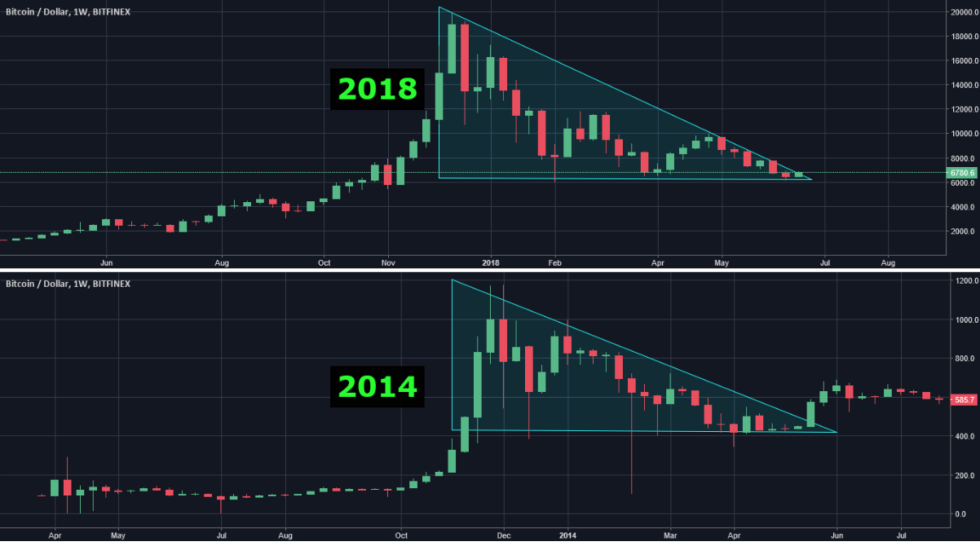Several key events will take place on the digital money market next year that can seriously affect the situation in the crypto and Bitcoin community.
In 2018, the prices of cryptocurrencies have been continuously decreasing, and Bitcoin (BTC) 00 has already fallen in price by 80% from $20,000 to $4,000. The total capitalization of the blockchain industry has decreased by 84%. If, in January, the market cap was $830 billion, then by the end of November the figure fell to $130 billion.
Recently, interest in cryptocurrencies has been growing again and the market has risen to its values of April this year. The attitude of users towards digital currencies has undergone changes as well. According to Google Trends, most people are now wondering whether the bubble has burst, whether the current situation will lead to the depreciation of digital currencies and their ultimate downfall, given that the mood on the market is not very positive. Bitcoin has repeatedly dropped in price quite steeply, and if we compare its charts from 2018 with the values of 2014 we can see that the industry is currently in a similar situation that it was in four years ago.
But, this situation applies only to the prices of cryptocurrencies. Much has changed since then in terms of market development, as governments have started regulating the digital industry, while some like the Chinese authorities have banned it altogether.

Large financial institutions are constantly announcing plans regarding the launch of cryptocurrency-related products and integrating blockchain in their current business model. In September global banking giants UBS Group AG, Santander, Deutsche Bank, Bank of New York Mellon Corporation, and the British broker ICAP teamed up to issue a new digital currency based on blockchain technology, which is supposed to be used for performing bitcoin transactions.
However, the industry is only at the dawn of its development, so there are many obstacles that are preventing companies from entering the market.
On September 20, the representatives of large Russian banks declared their readiness to work with cryptocurrencies, but they cannot start rendering such services due to the lack of regulation in the country. The bank officials also stated that there is considerable customer interest in digital currencies, and announced active testing of blockchain technologies.
Many large organizations are preparing to enter the cryptocurrency market in 2019. These events can significantly change the situation in the industry, and the price of Bitcoin will rise once again, as predicted by such well-known experts like head of Fundstrat Tom Lee with his $15,000 mark forecast, Chairman of the New York Stock Exchange Jeff Sprecher with his “Bitcoin and digital assets are here to stay” appeal, and billionaire Mike Novogratz. The latter believes the market may see new highs in 2019:
I fundamentally think you’re going to see big adaption in 2019, 2020,” he said. “Lots of the items in the digital world, the e-gaming space, are low value items so I think people will be more comfortable participating in blockchain.
Bakkt — a Platform For Institutional Investors
The operator of the New York Intercontinental Exchange (ICE) is preparing to launch Bakkt, a platform for institutional investors. Its first product will be Bitcoin futures with physical asset backing. The plan was that the platform would start working on December 12, 2018, but the start had to be postponed to January 24, 2019, due to the large influx of customers.
At the end of November, head of Bakkt, Kelly Lefler, said that the current value of Bitcoin is not important for the company. In her opinion, it is now important to compensate for the missing infrastructure elements and unimplemented application scenarios, which will positively affect the development of the industry.
Asked if price is important, Kelly Loeffler, CEO of @Bakkt, says it is immaterial to what the new platform is working on: “The price is being expressed but there’s a lot of missing infrastructure and use cases.” #ConsensusInvest
— CoinDesk (@coindesk) November 27, 2018
Fidelity Investments
The Fidelity Investments holding company, which manages assets worth $2.1 trillion is launching its own cryptocurrency investment platform. The organization will not open an exchange for trading digital currencies, as it is preparing to release products for storing large volumes of assets of institutional investors who are interested in the industry.
According to Fidelity President, Tom Jessop, market analysts, hedge fund managers, and family capital management divisions are actively involved in the development of cryptocurrency-related products and instruments. As such, the expert believes that the situation in the industry can change for the better.
Bitcoin ETF and SEC
The US Securities and Exchange Commission (SEC) is studying an application to launch a Bitcoin ETF from the SolidX cryptocurrency startup, which filed the application back in March 2016. On June 5, it was joined by VanEck. The regulator has not yet made a decision on the issue, but it is expected to release a definitive statement by March 2019.
According to many experts, this is a very important event for the cryptocurrency market. Investor and financial consultant from Wall Street, Ric Edelman believes that the market situation will change and it will no longer resemble the “Wild West” after the approval of cryptocurrency ETFs.
He also shares Sprecher’s opinion that Bitcoin is “here to stay”.
Why I’m increasingly convinced that #bitcoin and other #cryptoassets are legitimate and here to stay: https://t.co/REqp1pfwdg @EdelmanFinServ pic.twitter.com/cpE9zoVqwN
— Ric Edelman (@ricedelman) September 3, 2018
According to the head of VanEck, Gabor Gurbacs, a new instrument may be approved in the near future, as the company has never been so close to receiving a positive verdict from the regulator.
This is not being denied by SEC representative Hester Peirce, as she believes that the agency should be more loyal to Bitcoin-ETF, while Securities and Exchange Commission chairman Jay Clayton said that such an outcome is possible only after the problem with market manipulations is resolved.
Bitcoin Futures from Nasdaq
On November 29, Bitcoinist reported that NASDAQ, one of the largest stock exchanges in the world, is preparing to launch futures for Bitcoin in cooperation with VanEck. The new product, which will be launched in the first quarter of 2019, will be focused on the spot price of Bitcoin from many exchanges, unlike the CME and CBOE, which use information from four and one platforms respectively.
The head of VanEck, Gabor Gurbacs, confirmed this information and stressed that if 2018 is considered to be the year of regulation, then 2019 will be the year of implementation. He said that the new product will be in the form of version 2.0. of regulated futures contracts.
After the opening of futures on the Chicago stock exchanges in December 2017, the value of the first cryptocurrency reached a historic high of $20,000, and in January 2018, the capitalization of the industry exceeded $830 billion.
A recently released Chicago Mercantile Exchange report shows that Bitcoin Futures daily trading volume is up by 41% in Q3. https://t.co/xRX0OlTKOh
— Bitcoinist.com (@bitcoinist) October 18, 2018
Services from Large Banks
Many large banks, such as Goldman Sachs, Morgan Stanley, CityGroup and others are preparing to launch cryptocurrency futures, derivatives or simply provide their customers with access to digital currencies. As reported by Bitcoinist on October 31, Goldman Sachs has already started attracting customers to launch Bitcoin derivatives, which would be similar to CME and CBOE futures, but would not be traded on the exchange.
In early November, Morgan Stanley published a report calling Bitcoin “a gold mine for institutional investors,” where it also draw a parallel between Bitcoin’s crash in 2018 and Nasdaq’s crash in 2000 and asked “whether the bear market is coming to an end in the way the Nasdaq’s did.”

In September, Bloomberg, citing anonymous sources, wrote that Morgan Stanley is preparing to launch swaps for the first cryptocurrency. The company already has the technology to launch the new service and is now studying the level of demand for it among large customers.
In mid-November, the head of the cryptocurrency division of the Susquehanna trading giant, Bart Smith, said that the launch of products from Fidelity and ICE would help increase the liquidity of Bitcoin and attract significant sums to the market, which will positively affect its development. Bitpay’s commercial director, Sonny Sing, shares the opinion and he is confident that these events will once again raise the price of the asset next year, and during 2019, it will cost between $15,000 and $20,000.
As #bitcoin plunges and nears $4,000, Wall Street’s Crypto King Bart Smith of Susquehanna says he’s still a long-term believer in the cryptocurrency. pic.twitter.com/SzsL9tZAhB
— CNBC’s Fast Money (@CNBCFastMoney) November 20, 2018
Regulation and Infrastructure
Experts in the field of finance and managers of large capitals are unanimous in their opinion that cryptocurrencies are in need of serious regulation and require a fundamental infrastructure buildup. If the first factor depends on the regulators, then the latter is up to blockchain projects. But, first things first.
In 2017, legislators from different countries studied the issue of cryptocurrency regulation and discussed this issue at the intergovernmental level at the G20 Summit. After finance ministers took a more positive approach to cryptocurrencies at the 2018’s G20 meeting in Argentina, Bitcoin prices topped $9,000.
Countries such as Estonia have achieved significant success in solving the issue of cryptocurrency regulation by implementing the concepts of the e-government and residency, as well as use of blockchain to protect access to citizens’ personal data. Malta is in the same league and has secured the status of a crypto island.
Said Joseph Muscat, the Prime Minister of Malta, during a speech at the 73rd session of the UN General Assembly:
Blockchain makes cryptocurrencies — the inevitable future of money — more transparent, since it helps filter good business from bad business, but these distributed ledger technologies can do so much more.
Such a state position in relation to cryptocurrencies is suitable for projects that are intent on deploying a large-scale infrastructure. The FOTON decentralized crypto-bank is developing a solution for conducting multicurrency transactions with a single system of integrated fiat and cryptocurrency exchanges and instant payments for goods and services. In addition to relatively young projects, a number of major exchanges have made their choice in favor of Malta, including Binance, OKEx, ZB.com, as well as such famous blockchain projects as TRON, Big One, Cubits, Bitpay and others.
BitPay’s website states:
BitBay has been conducting analyses for many months within the scope of the most friendly jurisdiction for cryptocurrency in the European Union. Productive discussions with the government of Republic of Malta and friendly business environment provide BitBay assurance that the choice of Maltese jurisdiction is the best solution.
The current market situation that is associated with a significant fall in cryptocurrency capitalization will neutralize speculators and projects that have no real value and proven liquidity. In the near future, we will probably see a recovery of the market and its growth thanks to a more developed infrastructure and civilized regulation.
Disclaimer: This publication does should not be considered as investment advice and has been written solely for the purpose of providing an overview of the market and experts’ insights.
[Note: This is a guest article submitted by Julia Magas]
What are your thoughts on the hopes for Bitcoin’s future? Don’t hesitate to let us know in the comments below!
Images and media courtesy of Bitcoinist archives, Shutterstock, Twitter (@CNBCFastMoney, @coindesk, @ricedelman).







